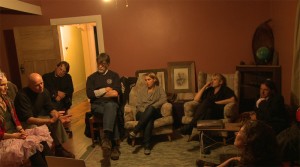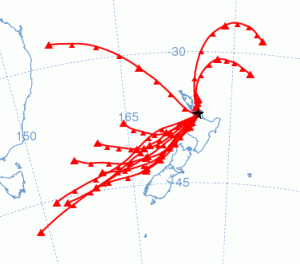Relating to [maori] elders what had just happened at Hiroshima and Nagasaki, the elders responded by saying, ‘so the pakeha have ripped the fabric of the universe?’ Yes. ‘Oh and I assume they don’t know how to stitch it back up.’
– A story told by Bishop Muru Walters, recounted by Andrea Polli

In the loungeroom, Ian Clothier, Mark Thornton, Andrea Polli, Janine Randerson, Keith Woodley, Ben Bamsterboer, Kanani Cowell, Trudy Lane (by discipline: Artist/Curator, Classics and Maths Teacher, Artist, Artist, Shorebird Centre Manager, Local Artist, Local Artist/Farmer, Artist/Curator)

Below: NOAA-Hysplit rendering of the paths the air breathed that night had taken in the six hours prior. Shown as part of a discussion of Ramon Guardan’s SCANZ 2011: Eco sapiens work, on the interconnected circulation of the global oceans of air.
In Atmospherics, US artist Andrea Polli created a data sonification of the awesome power and complexity of a hurricane, allowing listeners to travel five elevations within it[1]. Her work Ground Truth (part 1) – involving interviews with scientists about their physical ‘reading’ of natural phenomena – further overlapped my research areas. Hence her trip to New Zealand presented a starting point and I began to form a dinner stemming from meteorology, and atmospherics, and an everyday wonder of water, as a meditation on interconnection.
In order to disclose connections between guests both known and unknown to myself I wished to trial a more formal sharing session than had been enacted at the previous Wonderlogue. So after dinner we ‘adjourned’ to the loungeroom for this, a more formal part of the evening.
Amid the Eco sapiens hui in January, a sister-event of the Wonderlogues, Matehuirua Limmer of our paepae had given me guidance regarding the whakawhanaungatanga (introductions) process, explaining it as revealing that we are all in fact connected, by water. Thus with the images of my great grandparents listening in, and gathered where my father once gathered people for bible study, I related this guidance from Matehuirua to the group as I set off a sharing session of the participants own ‘fascinations’ and intrigues about the topic of the evening.
Post-dinner and with wines, the sharing session was an informal space which ranged from discussions of the travel of air particulates, in relation to the recent nuclear concerns in Japan to reflections on youthful perception of waterway areas in Dunedin.
I started things off by discussing the work of the meteorologist and ecologist Ramon Guardans, who had been a participant at the SCANZ 2011: Eco sapiens gathering and practised also in the visualisation/sonificaiton of scientific data. This was his work From the Bottom of an Ocean of Air done in collaboration with two other participants, Tega Brain and Kirsty Boyle. Also his Where was the Wind?, an installation which utilised the online NOAA Hysplit model which can allow you to see air flows and where they have come from, or are predicted to travel to, in a given time period. By activating a rendering to see where the air we were breathing that night had come from six hours earlier, visually illustrated the concept of ourselves as living at the bottom of the great swirling pools of globally interconnected air. As a meteorologist, Ramon also considers himself an ecologist, as these air currents intersect all of these localities that they encounter. Our ideas of ourselves in separate nationalities literally goes to and flying out with the wind.
There were many other discussions of connections to water for people’s conception of themselves, such as Ian’s parents meeting while bumping into each other swimming. From a local artist, Ben Bamsterboer, there was also an impassioned plea for the sanctity of water from a local artist based on the writings of Viktor Schauberger – who called for the regard of water as a living as ‘a living substance’. Selected excerpts from this evening I will post to this page.
[1] Andrea Polli’s Atmospherics is an interactive work that allows viewers to listen to the sound of data generated by a hurricane that devastated the New York area in 1991. The compositions allow listeners to experience geographically scaled events on a human scale. Atmospherics can be viewed here: http://artport.whitney.org/gatepages/may04.shtml. More information on Andrea’s projects can be found here: http://www.andreapolli.com/
